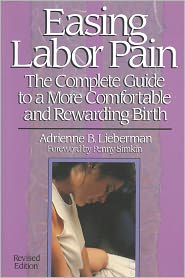by Adrienne B.Lieberman

What Does Labor Feel Like?
From the intense, cramping pull or squeeze of the dilating contractions to the profound stretching sensation as the baby’s head moves down the birth canal, labor is characterized by powerful feelings. Some women describe the dilating contractions in terms of a more familiar sensation–a cramp, like a menstrual cramp; a charley horse; a gas pain; or a feeling of rectal pressure. One mother says her contractions were like “strong gas pains, tremendous pressure around the pubic area.” Another describes labor as “huge waves, like diarrhea cramps, one after the other.” Still another says, “My labor felt like extraordinarily severe menstrual cramps with a lot of pressure on the rectum, like constant pressure to have a bowel movement.”
Confronting the intensity of pain before you give birth may motivate you to learn ways of dealing with it more adequately when you’re actually in labor. In fact, a study published recently in Birth suggests that women with higher levels of fear before their first childbirth class actually reported less anxiety during labor and delivery. The authors concluded that these women probably had dealt with their concerns before they went into labor.
One woman, for example, coped with the pain by envisioning the purpose of each contraction: “I visualized my uterus rising up and pulling back, opening the cervix more and more with each contraction.”
Why Is Labor Painful?

Labor is usually painful for several very good reasons. For one, the cervix, completely insensitive to burning and cauterization, is nevertheless extremely sensitive to pressure and stretching–precisely what it undergoes during labor. Most women feel contractions as cramping sensations in the groin or back, though some experience more pain in their sides or thighs. As the contractions get longer, stronger, and closer together over the course of labor, they will be perceived as more or less painful by different women.
In addition, the uterine muscle–at term, the largest and strongest muscle in your body–may have to work at alternately contracting and relaxing for hour after hour. That can lead to a tired, achy feeling, just the way the voluntary muscles in your arms and legs might feel exhausted and sore after a difficult workout. The normal decrease in oxygen flow to the uterus as it contracts can add to that achy feeling.
During labor a lot of pressure may be exerted on the fallopian tubes, ovaries, and ligaments. The baby’s presenting part (usually the head) presses firmly against your bladder and bowel as he descends through your pelvis. This can lead to great pain, particularly if you don’t empty your bladder frequently. About once an hour is a good rule to remember.
The rectum usually empties itself (“nature’s diarrhea”) in early labor. If it doesn’t, you may choose an enema to give your baby more room (see chapter 17). Whether your rectum is empty or not, the pressure of the baby’s head on surrounding nerves will be surprising. This feels as though you are going to have a bowel movement right now. To some women, that feeling of rectal pressure is extremely painful.
When you are in the pushing or second stage of labor, you will probably feel an extraordinary sensation of stretching in your vagina. “I felt,” said one mother, “as if I would burst.” Birth is a normal function, of course, but it’s hardly an everyday feeling.
Dr. Ronald Melzack, professor of psychology at McGill University and a noted pain researcher, helped develop the McGill Pain Questionnaire to answer just such questions. The McGill Pain Questionnaire characterizes different types of pain in terms of their distinctive attributes (like throbbing, burning, rhythmic, pounding, etc.) and also allows a rating of the intensity of any pain on a scale from “none” to .excruciating.”
According to Melzack, “Labor is … among the most severe pains that have been recorded with the McGill Pain Questionnaire.” But while the average labor was indeed rated as very painful, women’s scores ranged widely. A few mothers reported easy, almost pain-free labors while others experienced extremely difficult ones.
Whether or not a woman had a baby before seemed to make a big difference. In an early study, Melzack and his associates queried 141 women, 54 of whom had a previous baby and 87 first-time mothers. One in four of the first-time mothers rated labor as horrible or excruciating, while only one in 11 of the experienced mothers rated their labors this harshly. The proportions were reversed at the bottom end of the range, with only one in 11 first-time mothers but one in four experienced mothers rating their labors as mild.
Also, change the meaning of the situation to make it more or less painful. One study, for example, showed that women who had previously experienced high levels of pain unrelated to childbirth reported less labor pain than other women.
Another recent study compared Dutch and American women giving birth. American women were much more likely to expect labor to be painful and to assume that they would need medication for it. They predicted correctly. Indeed, only one in six American women received no medication compared to almost two-thirds of the Dutch women.
The biggest difference among people, however, isn’t in their perception of pain but in their ability and motivation to withstand it. In one experiment, for example, Jewish women increased their level of tolerance after they were told that their religious group had a lower pain tolerance than others.
It’s well known that a person may have a low tolerance for pain in one situation, but a high tolerance in another. For example, soldiers whose severe wounds would warrant strong painkillers in a civilian population nevertheless denied feeling high levels of pain when they were interviewed away from the battleground. Athletes are often observed to continue playing despite injuries that a non-player probably would find quite painful.
Your pain threshold can also be lowered or raised by the type of attention you focus on a sensation. In one pain experiment, simply reading the word “pain” in the instructions made subjects find a low level of electric shock painful. They didn’t report the same level of shock painful when the suggestive word “pain” was left out of the instructions. This, of course, is the reason childbirth teachers refer to “labor contractions” and not to “labor pains.”
By the same token, if your anxiety is reduced instead of built up, your pain threshold may be increased. Another pain experiment gave subjects control over the painful stimulus, an electric shock. With a sense of control, subjects found the stimulus less painful, probably because they experienced less anxiety about what would happen to them.
Reducing Labor Pain
Because pain perception is so malleable, you can reduce the pain you feel during labor in a variety of ways. You may be able to alter the physical sensation itself, say, by changing your own position. Perhaps you’ll choose to intercept the pain message, closing the gate or jamming the transmission of pain by sending competing soothing messages–counterpressure, massage, or TENS are but a few of the means to do this.
You’ll probably also use many psychological methods of restructuring the pain messages, like tuning into your body and employing positive imagery to reinterpret painful sensations as “opening” or “the baby descending.” You can soothe yourself with attention-focusing devices such as relaxation, slowed breathing, and music; and you can supply yourself with calming sights to look at, and special companions to comfort you. Perhaps you’ll choose to concentrate on so-called left-brain (rational) activities–counting to yourself, pacing or patterning your breathing, focusing on a particular picture, or listening to your partner count time on a watch. Practicing lots of strategies and being flexible about changing strategies midstream can help you get through the painful contractions and prevent you from tensing up in anticipation of future pain.
All these techniques represent merely the tip of the iceberg of methods you can use to lessen the pain of birth. Many ways exist to respond to the challenge of bringing a new life into the world, and we’ll explore a good number of them in detail. With education, practice, and commitment, you’ll be well equipped to help yourself alleviate pain and get the most out of your birth experience.
How do you picture yourself during labor? Perhaps you’ve imagined yourself getting into bed, pulling up the covers, and simply lying there awaiting your baby’s birth. Your husband mops your face with a wet washcloth while doctors and nurses flutter around your bedside. This image bears little resemblance to reality. If you really want to have your baby more quickly and with less pain, plan to get up and keep moving around as long as you can through labor. Since having a baby requires active participation on your part, you may want to prepare yourself to help the process by engaging in an exercise program during pregnancy. In your childbirth preparation class you’ll probably learn several stretches to promote good posture and the proper functioning of the muscles that support your uterus.
You may also want to get involved in some regular aerobic exercise that pushes your heart and lungs to perform at their peak level. Aerobic exercise during pregnancy provides many benefits. It can build stamina, make you more comfortable, alleviate aches and pains, and relieve stress.
Aerobic exercise may even make your labor shorter and less painful. An American study published recently in the American Journal of Obstetrics and Gynecology reported that women who continued running or aerobic dancing during pregnancy enjoyed labors about 30 percent shorter than women who stopped exercising. Women who maintained a regular exercise program also required less labor stimulation and fewer epidurals, episiotomies, and cesarean deliveries. An Italian study in the same journal examined women having their second or third babies who pedaled on stationary bicycles three times a week for 30 minutes beginning around the fifth month of pregnancy. The bicyclists maintained higher endorphin levels during labor. Accordingly, they reported less pain than a matching group of sedentary women.
Even if regular exercise can’t guarantee you a shorter or easier labor, it undoubtedly can help you to cope better with whatever labor has in store for you. Going into labor physically fit also means you will recover more quickly afterward.
The aerobic exercises of swimming, walking, and bicycling are readily available to most pregnant women. Or, you may choose to take an exercise class or purchase an exercise videotape (see Resources). Some women even continue jogging through their entire pregnancies. Be sure to get your doctor’s approval before embarking on an exercise program, especially if you have medical problems such as high blood pressure. You should also be aware of the following precautions.
The American College of Obstetricians and Gynecologists has established these guidelines to help prevent your core body temperature from rising too high and possibly harming your baby:
- Keep your heart rate under 140 beats per minute during exercise.
- Check your temperature by armpit or rectum at the end of your usual exercise to make sure it is less than 101 degrees.
- Limit very strenuous exercise to 15 minutes at a time.
- Replenish fluids after exercising.
- Avoid exercising outdoors in very hot weather or if you have a fever.
- Walking through Labor
Given freedom of choice, few women in any part of the world lie down during labor. The supine (flat on the back) position reportedly originated in the French court of Louis XIV. A voyeur who relished watching his mistress giving birth, the king’s quirky preferences soon dictated fashion for the country. The supine position found almost universal favor in United States hospitals from the 1940s on because a woman’s lying flat enabled her obstetrician to perform interventions such as forceps delivery, anesthesia, and episiotomy more easily.
But lying down has no medical benefits for most mothers. In fact, it carries several proven risks. When you lie on your back for long periods of time, the weight of the uterus compresses the descending aorta and inferior vena cava, blood vessels that supply or drain the lower part of your body. This interference with your circulation reduces your blood pressure, compromising blood flow to your baby and causing his heart rate to drop. When you stay upright (or at least off your back), placental circulation improves and fetal heart rate abnormalities may be alleviated.
A host of medical studies have demonstrated conclusively that upright positions shorten and ease labor. One famous Latin American study comparing reclining to vertical positions showed that labors for women who stayed upright were 36 percent shorter for first-time mothers and 25 percent shorter for mothers who had previously given birth. A British study comparing mothers who walked during labor to mothers who stayed in bed demonstrated that walking not only shortened labor but also reduced pain and the need for medication.
How does walking help your labor along? For one thing, your contractions become stronger, more regular, and more frequent when you stand up. Gravity helps your baby make his way through your pelvis. Furthermore, the upright position improves both the angle of your baby’s body to your spine and the application of his head to your cervix. Because your uterus naturally tilts forward in your abdomen during contractions, it meets the least resistance when you are standing, leaning slightly forward. Finally, even though contractions get stronger when you’re upright, many women feel more comfortable, more in charge, and better able to relax in this position. A typical mother put it this way: “When I lay down, it slowed my labor down in the early stage. When I was in active labor, I found lying down much more painful than when I was walking.”
To promote your labor, keep walking as long as you can. One couple took a scenic stroll along the lakefront near their home before checking into the hospital when the woman’s contractions were three minutes apart. Another mother remembers “walking and walking and walking around the apartment. During a contraction I would just hold onto something for support–a chair or my husband.
Because you’ll probably need to rest while you’re having contractions, learn to lean on your partner in a manner that won’t make him sore the next day. Janet Balaskas, the author of Active Birth, suggests this as the best way for your partner to carry your weight properly: As you drape yourself around your partner, he should keep his shoulders down, bend his knees, and lean back slightly while tightening his buttocks. It’s especially important for your partner not to bend forward with raised shoulders, because this will give him a backache.
Changing Positions during Labor

Joyce Roberts, Ph.D., Professor of Maternal-Child Nursing at the University of Illinois at Chicago, has spent years researching positions for labor and delivery. Roberts points out, “A woman’s contractions are most efficient if she alternately sits and stands during labor.” It’s also necessary, she says, to adopt positions that are comfortable and appropriate for your particular labor.
For example, you may need to be in bed because of bleeding, fetal distress, or premature rupture of membranes with your baby’s head in a high position. If you have received an epidural, you have to stay in bed. If you are instructed to lie on your back, make sure your head is elevated with pillows and that you have a pillow or rolled-up blanket under one hip to tilt your uterus off your backbone. According to Roberts, alternating every half hour between lying on your back and lying on your side can help prevent the adverse effects reclining has on your blood pressure, your baby’s heart rate, and your labor’s progress.
Side-lying makes contractions less frequent than when you are standing, but they are also more efficient. Best of all, side-lying is good for your blood pressure. In fact, because it enhances circulation to your uterus, this position is often employed when a baby appears to be in distress.
As long as your labor is progressing normally, however, you may want to try any or all of the following positions in preference to lying flat, which tends to lengthen your labor and add to its risk and discomfort:
- STAND, leaning against your partner, a high counter, or a bed.
- KNEEL on all fours or with your arms and head against some pillows on an upraised bed. You could also try this on the floor, leaning on a cushion placed on the seat of a chair.
- HALF-KNEEL, HALF-SQUAT, with one knee up and one knee down, in bed or on the floor. This is easier than squatting, described below. If it feels good to you, rock back and forth toward your raised knee during the contractions. Change legs as needed.
- SIT UPRIGHT in bed or straddle a chair, leaning on a pillow on the back of the chair. A review of labor positions by the International Childbirth Education Association concluded that labor contractions were least efficient in sitting and supine positions. But sitting may still afford you a needed rest.
- SQUAT on the floor or on the bed. When you squat, your pelvic outlet opens to its widest diameter and your contractions will be strong and effective.
Before you go into labor, you should practice squatting to build up your endurance. With your feet one and a half to two feet apart and your heels flat on the floor, descend gradually, without bouncing, and hold the squat for 15 to 20 seconds. Work up to holding this position for a minute at a time. If you have trouble keeping your feet flat, widen your stance a bit, or try putting a rolled blanket under your heels, or wearing low heels, or sitting on a short stack of books. Rise up slowly and repeat several times. If you need help balancing, lean against your partner or grasp a chair or bed. It’s not a problem if your knees “crack,” but don’t do this exercise if you feel pain in your knees or pubic joint.
During labor you can vary the squatting position by squatting on the floor, leaning on a chair or on the labor bed. Or ask your partner to sit down on the bed or chair; facing away from him, try dangling into a squat, resting your elbows on his knees.
You could also squat in bed, supported under your arms on one side by your partner and on the other by a nurse. Or try squatting on the side of the bed with your arms draped around your partner’s neck. Your partner could even sit behind you in bed, toboggan-style, supporting you under the arms as you squat. You could sit-squat on the low footstool in the labor room. Put a pillow and sterile pad on it, and just sit down with your knees higher than your hips. Or perch on a short pile of books, a large cushion, or a beanbag chair.
Look at the positions illustrated in the book. Incorporate them into your practice of prepared childbirth techniques, so you can find out which ones are most comfortable for you and your partner.
One mother who moved around a lot during her labor remembers, “standing, holding on to the bureau, and literally dancing through the contractions. At times I would go from sitting to standing to all fours. My husband danced along next to me, wiping my face with a cloth, following me when I started walking, letting me hold on to him. During transition, I climbed on the bed and got onto all fours, then walked around again when the contraction was over.”
You’re probably wondering how you can do all this when standard hospital routines–fetal monitoring and IVs, for example–appear to command your complete immobility. It may not be easy.
You’ll need to negotiate with your doctor well in advance of going into labor and come to a meeting of minds about the conduct of your birth. Many physicians insist on continuous electronic fetal monitoring and IVs in high-risk labors. But women may be monitored by remote control or on an intermittent basis, preserving their ability to move around. If an IV is medically necessary, it can be attached to a mobile pole, if your doctor agrees (see chapter 17).
If you learn that your hospital’s or doctor’s custom is to confine all women to bed for the duration of labor, you may want to express your own wishes and come to a compromise. It may be a good idea to have any agreement you reach entered into your chart, especially if your doctor might not be at the hospital while you are in labor.
You could plan simply to arrive at the hospital at a point late enough in labor that you are willing to get into bed. Or you may decide to switch to a birthing environment that respects your need to be comfortably active during labor.
Excerpt reprinted with permission from foxcontent.com

- Prenatal Development Chart
- Active Birth: The New Approach to Giving Birth Naturally
- A Good Birth, A Safe Birth: choosing and having the childbirth experience you want
- Easing Labor Pain: the complete guide to a more comfortable and rewarding birth
- The Birth Partner: everything you need to know to help a woman through childbirth

